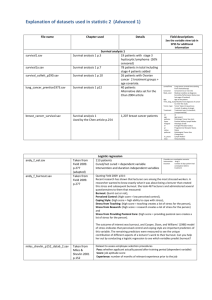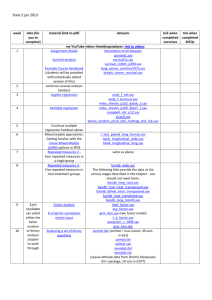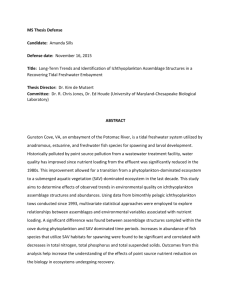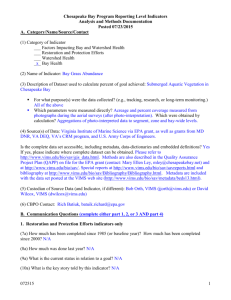Impacts of oil intrusion on critical nursery habitats and habitat
advertisement
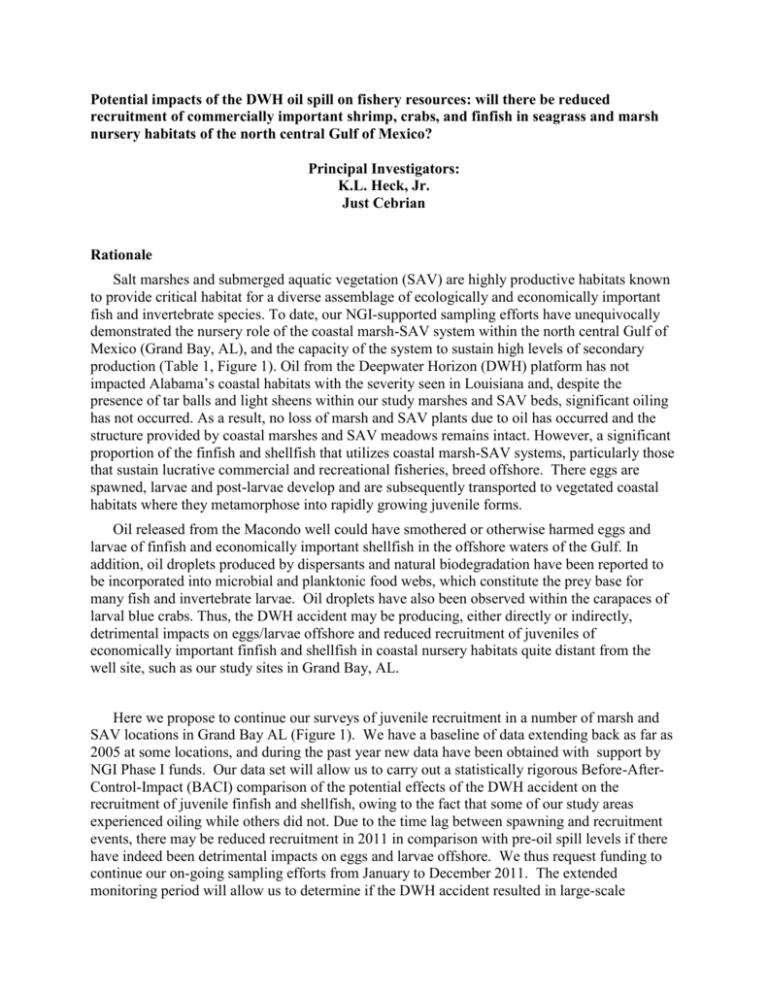
Potential impacts of the DWH oil spill on fishery resources: will there be reduced recruitment of commercially important shrimp, crabs, and finfish in seagrass and marsh nursery habitats of the north central Gulf of Mexico? Principal Investigators: K.L. Heck, Jr. Just Cebrian Rationale Salt marshes and submerged aquatic vegetation (SAV) are highly productive habitats known to provide critical habitat for a diverse assemblage of ecologically and economically important fish and invertebrate species. To date, our NGI-supported sampling efforts have unequivocally demonstrated the nursery role of the coastal marsh-SAV system within the north central Gulf of Mexico (Grand Bay, AL), and the capacity of the system to sustain high levels of secondary production (Table 1, Figure 1). Oil from the Deepwater Horizon (DWH) platform has not impacted Alabama’s coastal habitats with the severity seen in Louisiana and, despite the presence of tar balls and light sheens within our study marshes and SAV beds, significant oiling has not occurred. As a result, no loss of marsh and SAV plants due to oil has occurred and the structure provided by coastal marshes and SAV meadows remains intact. However, a significant proportion of the finfish and shellfish that utilizes coastal marsh-SAV systems, particularly those that sustain lucrative commercial and recreational fisheries, breed offshore. There eggs are spawned, larvae and post-larvae develop and are subsequently transported to vegetated coastal habitats where they metamorphose into rapidly growing juvenile forms. Oil released from the Macondo well could have smothered or otherwise harmed eggs and larvae of finfish and economically important shellfish in the offshore waters of the Gulf. In addition, oil droplets produced by dispersants and natural biodegradation have been reported to be incorporated into microbial and planktonic food webs, which constitute the prey base for many fish and invertebrate larvae. Oil droplets have also been observed within the carapaces of larval blue crabs. Thus, the DWH accident may be producing, either directly or indirectly, detrimental impacts on eggs/larvae offshore and reduced recruitment of juveniles of economically important finfish and shellfish in coastal nursery habitats quite distant from the well site, such as our study sites in Grand Bay, AL. Here we propose to continue our surveys of juvenile recruitment in a number of marsh and SAV locations in Grand Bay AL (Figure 1). We have a baseline of data extending back as far as 2005 at some locations, and during the past year new data have been obtained with support by NGI Phase I funds. Our data set will allow us to carry out a statistically rigorous Before-AfterControl-Impact (BACI) comparison of the potential effects of the DWH accident on the recruitment of juvenile finfish and shellfish, owing to the fact that some of our study areas experienced oiling while others did not. Due to the time lag between spawning and recruitment events, there may be reduced recruitment in 2011 in comparison with pre-oil spill levels if there have indeed been detrimental impacts on eggs and larvae offshore. We thus request funding to continue our on-going sampling efforts from January to December 2011. The extended monitoring period will allow us to determine if the DWH accident resulted in large-scale perturbations in the northern Gulf through depressed finfish and shellfish recruitment in critical nursery habitats. Selected Results from NGI Phase I We have made monthly nekton collections within the salt-marsh and SAV habitats of Grand Bay, AL (Figure 1) during the summer and fall of 2010, and have identified 27 marsh-associated species and 26 SAV-associated species of fish and invertebrates. Marsh catches were dominated by grass shrimp, Palaemonetes pugio, and SAV catches were by the following fish species: pinfish, Lagodon rhomboides; bay anchovy, Anchoa mitchilli; and silver perch, Bairdiella chrysoura. A list of other species found in significant numbers in these habitats is provided in Table 1. Following P. pugio, the economically important blue crab and penaeid shrimp species, as well as white and spotted sea trout, accounted for the greatest number of individuals within the marsh and SAV habitats. It is also important to note that juveniles of gray snapper, Lutjanus griseus and red drum, Sciaenops ocellatu and gulf menhaden, Brevoortia patronas, were collected in the SAV locations, although at lower abundances. Expected results Data from the extended survey period requested here will allow us to: -- Gather evidence of economically important impacts of the DWH accident in the north central Gulf of Mexico, if they exist, by quantitatively comparing (with BACI analysis) juvenile recruitment of finfish and shellfish in relation to pre-accident levels. -- Respond to additional oiling of marshes and SAV beds that might occur during the project period (i.e., if noticeable quantities of oil arrive from offshore and persist in our study locations), by assessing its effects on marsh and SAV plant biomass and species composition, as well as further impacts on juvenile finfish and shellfish abundance and species composition. Methods We will continue to sample nekton assemblages at each of the established study sites in Grand Bay, AL (Figure 1). The shoreline at each site is populated by Spartina alternifloradominated marsh, and the seagrass Halodule wrightii forms extensive meadows in the adjacent subtidal areas. At each site marsh-associated nekton will be sampled by placing three 6-m wide, tidal fyke nets along the marsh edge for a full tidal period. The nets are designed to capture organisms as they exit the marsh during the outgoing tide. Three 5-m otter trawl swaths will be made to sample the SAV-associated fauna at each site. Salt-marsh and SAV nekton samples will be collected throughout 2011, first in February to detect early recruitment, and then monthly from April to October during the main portion of the recruitment period, and finally in December. We will spatially and temporally pair our sampling of marsh and SAV habitats so that collections in each habitat will be separated by no more than one tidal cycle. All organisms will be enumerated and measured following collection. In addition, we will preserve individuals of selected economically important finfish and shellfish species for future hydrocarbon and oil ID analysis, if that becomes desirable after the sampling has been completed. Spartina densities will be assessed using permanently established quadrats installed at each site in summer 2010. SAV density and biomass in the trawled meadows will be sampled through coring. Environmental data, including water temperature, salinity and dissolved oxygen, will be collected using a hand-held YSI unit. Subsurface irradiance (PAR) will be assessed at all SAV meadows using LICOR sensors. Plant and environmental samples will be taken along with the nekton samples. Table 1. Mean Catch-per-Unit-Effort (CPUE) ± SE for selected species in the salt-marsh and SAV habitats of Grand Bay, AL. Means represent pooled catches for fyke nets (marsh; n=3 per site) and trawls (SAV; n=3 per site) across sites (n=3 sites) for three sampling dates (total of 27 samples). CPUE values for marsh catches correspond to the total number of individuals collected per tidal period. CPUE values for SAV catches correspond to the number of individuals collected during a 2-min trawl swath. Species Marsh SAV 27.8 ± 4.7 9.0 ± 4.4 60.4 ± 15.4 6.6 ± 4.5 Brown Shrimp Farfantepenaeus aztecus 4.6 ± 1.0 22.7 ± 9.1 White Trout Cynoscion arenarius 6.7 ± 3.8 0.0 Spotted Sea Trout Cynoscion nebulosus 0.8 ± 0.5 3.9 ± 1.0 Southern Kingfish Mentichirrus americanus 0.0 0.4 ± 0.1 Silver Mojarra Eucinostomus argenteus 0.0 0.5 ± 0.2 Sheepshead Archosargus probatocephalus 0.0 0.5 ± 0.2 Blue Crab Callinectes sapidus White Shrimp Litopenaeus setiferus Figure 1. Study sites within Grand Bay, AL. Budget: Double click on budget table below to activate Excel spreadsheet Project Title: Potential impacts of the DWH oil spill on fishery resources: Project Lead: Dr. K.L. Heck, Jr. Jan 1-Dec 30, 2011 I. Salaries $47,547 1a.1 Senior Personnel (K.L. Heck, Chief Scientist) $0 1a.2 Senior Personnel (J. Cebrian, Senior Marine Scientist III) $0 1b.1 Senior Personnel: (D. David, Research Associate) 25% $42,266 $10,567 1b.2 Senior Personnel: (J. Goff, Research Technician) 25% $35,000 $8,750 1b.3 Senior Personnel: (S. Havard, Research Technician) 25% $28,288 $7,072 1c.1 Graduate Students 50% $17,004 $8,502 1c.2 Graduate Students 25% $17,004 $4,251 1c.3 Student Interns (qty 2) 25% $33,614 $8,404 II. Fringe Benefits $16,017 2a.1 1a. Senior Personnel @ 0.00% $0 2a.2 1b. Senior Personnel (D. David) @ 44.11% $4,661 2a.3 1b. Senior Personnel (J. Goff) @ 48.81% $4,271 2a.3 1b. Senior Personnel (S. Havard) @ 55.31% $3,912 @ 15.00% $3,173 2b 1c Students 2c Tuition, Fees, and Insurance $0 month $0 III. Travel $4,575 IV. Commodities/Supplies $5,700 V. Equipment $0 VI. Contractuals $0 VII. Subcontracts Total Direct Costs 0 $0 $73,839 Budget Justification: Provide sufficient detail for a cost analysis of each applicable cost category. 1. Salaries (with description of duties) a. Senior Personnel (name and title, annual salary (12 month basis) and % of time) Insert additional lines in budget if necessary. i. Just Cebrian, Jr, Senior Marine Scientist III, no charge, 5% effort ii. Kenneth L. Heck, Jr, DISL Chief Scientist, no charge, 5% effort iii. Dorothy Byron, Research Associate (Heck Lab), $42,266, 25% -Lab Management, Field Team Leader, Data management and Quality Assurance iv. Josh Goff, Research Technician (Cebrian Lab), $35,000, 25% -Lab Management, Field Work, Data management and Quality Assurance v. Sharon Havard, Research Technician (Heck Lab), $28,288, 25% -Sample collection and processing and Quality Assurance b. Graduate Students (name and degree program, hourly rate, hours estimated) i. One MS graduate student in Dr. Cebrian’s Lab will be funded part time (50%) by this project ii. One MS graduate student in Dr. Heck’s Lab will be funded part time (25%) by this project c. Student Interns: $8.08/intern/hour, 520 hours estimated/intern -Sample Collection and processing. 2. Fringe Benefits (by Salary category, or employee listed, if unique rate) Fringe is calculated on a sliding scale. a. Senior Personnel: i. Just Cebrian: no charge ii. Kenneth L. Heck: no charge iii. Dorothy Byron : 44.11% iv. Josh Goff : 48.81% v. Sharon Havard: 55.31% b. Students: Includes graduate students and interns: 15% c. Tuition, Fees and Insurance 3. Travel (destination, estimate of transportation, accommodations, per diem, etc if >$5,000) a. We request $4575 for 27 sampling trips (3 trips per month for 9 months) using DISL vehicles and vessels. We estimate $1200 needed for vehicle use at $0.505/mile. Each sampling trip will travel approximately 40 miles round trip to launch in either Bayou la Batre, AL or Bayou Heron, MS. We estimate $3375 in vessel use at $125/8hr day to visit sites located in Grand Bay and Portersville Bay. 4. Commodities/ Supplies ( provide unit costs, if applicable) a. We request $5700 for the purchase of expendable supplies to be used during the project. These include basic field supplies such as pencils, markers, clipboards, all weather paper, ziploc bags, and additional protective gear such as nitrile gloves and any necessary protective gear (eg. waders). We have also included funds for the purchase of 3 new tidal fyke nets (including maintenance), a dissecting scope, and funds to calibrate the sensors and purchase sensor cables needed for measuring water clarity. 5. Equipment (Lease vs. purchase analysis if >$5,000) none 6. Contractuals none 7. Subcontracts – submit statement of work, budget and justification for each subcontract none Subcontra ct Poi nt of Conta ct: BUDGET REQUEST Funding Request I. Salaries $0 Sa l a ry 1a Name, Title $0 1b Name, Title 0 % effort 100% $ 100% II. Fringe Benefits 2a Category of employee $0 $0 @ 0.00% $0 III. Travel $0 IV. Commodities/Supplies $0 V. Equipment $0 VI. Contractuals $0 VII. Subcontracts $0 Total Direct Costs $0 Indirect (F & A) Costs $0 Total Costs $0 8. Indirect (F&A) Costs Indirect costs are calculated at 42.6% which is the current rate charged by the Dauphin Island Sea Lab.


